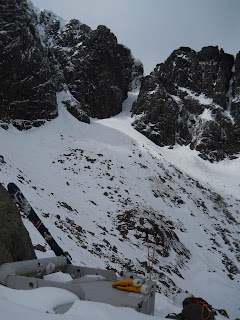This weekend I went out to run a loop based on the 'Kinder Killer' which is a circuit of Kinder - surely the best place for fell running in the peak - starting from Edale. The only catch is that every time you reach the plateau the route launches you back down into the valley, before immediately sending you back up to the plateau via the steepest clough it can find.
It's a cracking route, taking in lots of ascent and descent which is, on the whole, away from the main paths and I'd never run over lots of the route which made for an enjoyable and enlightening experience, exploring some of the less frequented parts of Kinder. The route I ran was slightly truncated from the 'official' Kinder Killer route as described here, but still covered about 25 rough miles and nearly 2500m of ascent. It's certainly good training for something like the Bob Graham, and 8-10 hours is supposed to be a reasonable time at "BG pace" so I was aiming for anything sub-8 hours on my little jaunt.
 |
| Slightly abridged version of the Kinder Killer |
From Edale you head straight up, I chose Ringing Roger but Grindsbrook is the official route, to hit the plateau and find the Druid's Stone. From here you launch down through the heather and bracken aiming for the Youth Hostel hidden in the depths of Lady Booth Brook. A bit of downclimbing(!) over some loose rocks gained the stream and, thankfully, a small path down to the hostel itself. A short section on a good track gains Jaggers Clough which is followed back up to the plateau with a fun bit of scrambling near the top. The futility of your day dawns on you as you immediately turn right and descend all the way back down to the Roman Road to the East, joining it less than a kilometer from where you started the ascent up Jaggers Clough.
From here a fast descent on a good track leads to Ashop farm, and a fantastic rough trod traverses the hillside to gain Blackden Brook. Another long climb here up the lonely but beautiful clough on the Northern Edge of Kinder gains the top again, but not for long. A quick jaunt along to Seal Stones marks the next descent and it's a good one, steep grassy tussocks gains a boggy track which allows another fast descent down Gate Side Clough all the way back to road level at the base of Fairbrook Clough. From here either climb up via the stream, or take the direct and very steep rib which runs up to Fairbrook Naze.
 |
| Seven laps up (and down) Kinder |
Take a breather on the next flat section (the only one) along the plateau before dropping down steeply to Ashop Head, and then William Clough to the bridge at the end of Kinder Reservior. The next climb either follows the River Kinder right up to the downfall, or takes the steep path direct up to Sandy Heys. It was on this ascent that I had a bit of a 'crash'; having left my jelly babies in the car I was in desperate need of some sugar and bagels just wouldn't fit the bill. My uphill march was more of a stagger by now, and I clearly looked wasted enough that a passing DofE group felt the need to shout encouragement at me. From the downfall I pressed on, and by the time I reached Kinder Low I had perked up enough to take on the final two climbs. I dropped down to Edale Cross, and then down Jacob's Ladder to below the Woolpacks. The next climb takes a pure fell-runners line straight up the hillside following an old fenceline to Crowden Tower, before coming straight back down again via Grindsbrook Clough. Rather than take the obvious (and alluring) path back to Edale it then goes off piste again. Another very steep and pathless climb will, for the strong-willed, gain Grindslow Knoll. From here it was a simple case of giving directions to a lost walker, and then dropping down the very fast descent back to the Nag's Head.
I think it took me about five and half hours round trip, with the legs still feeling fresh at the end which I was fairly happy with. I think my route is about 4.5km and 100m shorter than the 'official' route described, but I made my fair share of navigational errors which would probably even out some of that. As a route it's certainly good conditioning for a challenge such as the Bob Graham, I'm now trying to figure out if it's possible to shoehorn any more climbing into the route to make it more of a challenge :)
The rest of the weekend was spent with a productive session at Raven Tor, and then a little bit of summer gritstone climbing with a couple of friends.
 |
| Curly Chris on L'Horla at Curbar |
I'd also like to point out that a mate of mine just completed his first (and possibly only?!?) 100 mile ultra which is a pretty amazing effort and is raising money for charity in the process. If you'd like to donate go to:
www.justgiving.com/oscars100






































